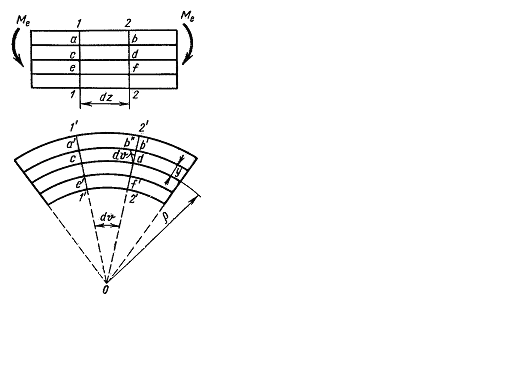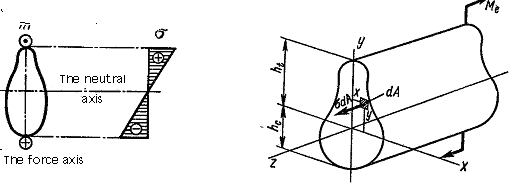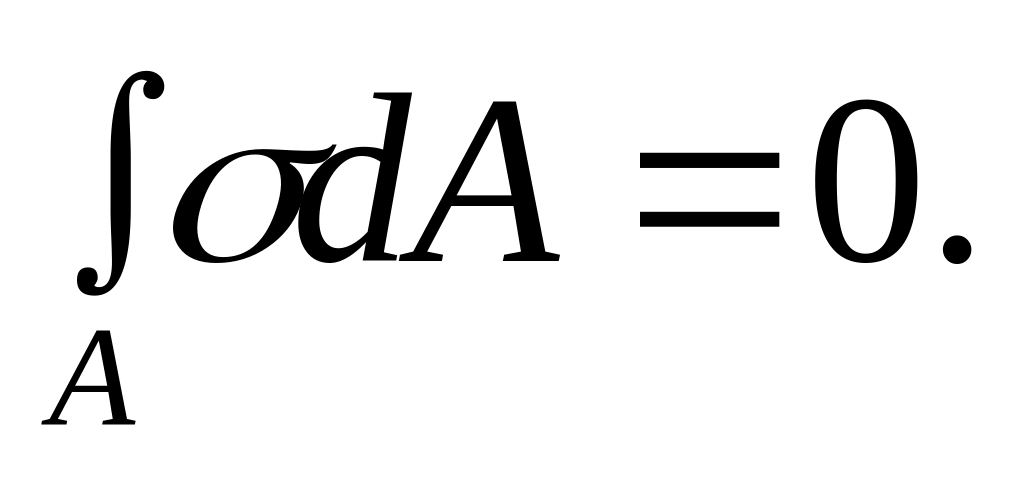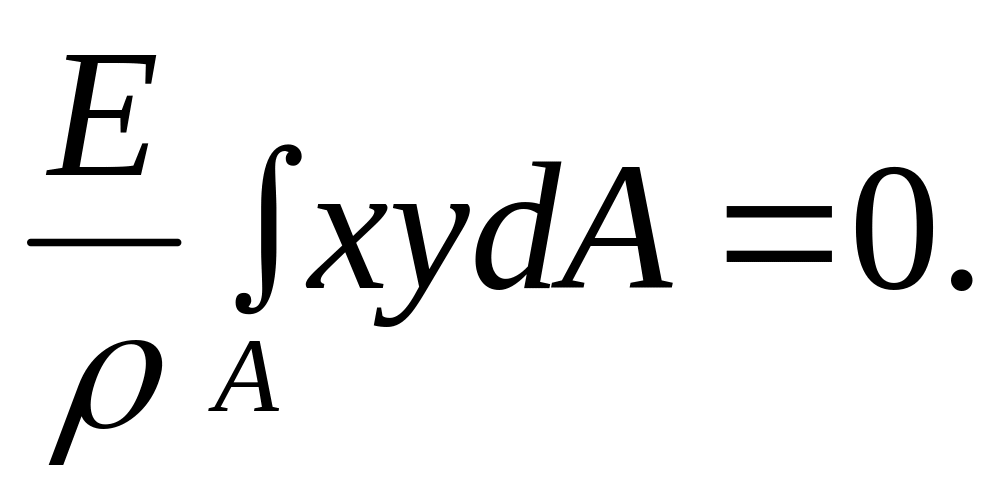
- •1. Основные понятия и положения 11
- •2. Центральное растяжение и сжатие стержня 17
- •3. Геометрические характеристики плоских сечений 42
- •4. Кручение 49
- •5. Изгиб стержней 57
- •Introduction 173
- •1. Basic concepts and principles 175
- •2. Tension and compression of a bar 181
- •3. Geometric characteristics of cross sections 202
- •4. Torsion 208
- •5. Bending of bars 216
- •Index 405 введение
- •1. Основные понятия и положения
- •1.1. Задачи сопротивления материалов, основные гипотезы и допущения
- •1.2. Типы нагрузок и деформаций
- •1.3. Определение внутренних усилий методом сечений. Напряжения
- •2. Центральное растяжение и сжатие стержня
- •2.1. Напряжения и продольная деформация при растяжении и сжатии
- •2.2. Закон Гука при растяжении и сжатии
- •2.3. Поперечная деформация при растяжении и сжатии
- •2.4. Диаграмма растяжения низкоуглеродистой стали
- •2.5. Потенциальная энергия деформации при растяжении
- •2.6. Расчеты на прочность при растяжении и сжатии
- •2.7. Статически неопределимые задачи
- •2.8. Напряжения в наклонных сечениях при растяжении (сжатии) в одном направлении
- •2.9. Закон парности касательных напряжений
- •2.10. Определение напряжений в наклонных сечениях при растяжении (сжатии) в двух направлениях
- •2.11. Определение главных напряжений и положения главных площадок
- •2.12. Зависимость между деформациями и напряжениями при плоском и объемном напряженных состояниях (обобщенный закон Гука)
- •2.13. Работа внешних и внутренних сил при растяжении (сжатии). Потенциальная энергия деформации
- •3. Геометрические характеристики плоских сечений
- •3.1. Статический момент площади
- •3.2. Полярный момент инерции
- •3.3. Осевой момент инерции
- •3.4. Момент инерции при параллельном переносе осей
- •3.5. Главные оси и главные моменты инерции
- •4. Кручение
- •4.1. Определение крутящего момента
- •4.2. Определение напряжений в стержнях круглого сечения
- •4.3. Деформации и перемещения при кручении валов
- •4.4. Потенциальная энергия при кручении
- •5. Изгиб стержней
- •5.1. Типы опор балок
- •5.2. Определение опорных реакций
- •5.3. Определение внутренних усилий при изгибе
- •5.4. Правило знаков для изгибающих моментов и поперечных сил
- •5.5. Дифференциальные зависимости при изгибе
- •5.6. Построение эпюр изгибающих моментов и поперечных сил
- •5.7. Определение нормальных напряжений
- •5.8. Условия прочности по нормальным напряжениям
- •5.9. Потенциальная энергия деформации при изгибе
- •5.10. Теорема о взаимности работ. Теорема о взаимности перемещений
- •5.11. Определение перемещений методом Мора
- •6. Теории прочности
- •6.1. Назначение гипотез прочности
- •6.2. Первая гипотеза прочности
- •6.3. Вторая и третья гипотезы прочности
- •6.4. Энергетические гипотезы прочности
- •7. Сложное сопротивление
- •7.1. Изгиб в двух плоскостях (косой изгиб)
- •7.2. Изгиб с растяжением (сжатием)
- •7.3. Внецентренное сжатие (растяжение)
- •7.4. Кручение с изгибом
- •7.5. Кручение с растяжением (сжатием)
- •7.6. Пример расчета вала на изгиб с кручением
- •8. Расчет тонкостенных сосудов
- •9. Расчет сжатых стержней на устойчивость (продольный изгиб)
- •9.1. Устойчивые и неустойчивые формы равновесия
- •9.2. Формула Эйлера для критической силы
- •9.3. Влияние способа закрепления концов стержня на критическую силу
- •9.4. Пределы применимости формулы Эйлера
- •9.5. Эмпирические формулы для определения критических напряжений
- •9.6. Практическая формула для расчета на устойчивость
- •10. Динамическое действие нагрузок
- •10.1. Динамические нагрузки
- •10.2. Вычисление напряжений при равноускоренном движении
- •10.3. Определение перемещений и напряжений при ударе
- •11. Расчет на прочность при напряжениях, циклически изменяющихся во времени (расчет на усталость)
- •11.1. Основные определения
- •11.2. Кривая усталости при симметричном цикле. Предел выносливости
- •11.3. Диаграммы предельных напряжений и амплитуд цикла
- •11.4. Факторы, влияющие на предел выносливости
- •11.5. Определение коэффициента запаса прочности при симметричном цикле
- •11.6. Определение коэффициента запаса прочности при асимметричном цикле напряжений
- •Предположим, что при увеличении нагрузки на деталь отношение Такое нагружение называется простым.
- •11.7. Практические меры повышения сопротивления усталости
- •Практикум Лабораторная работа № 1
- •Введение
- •Установка
- •Порядок выполнения
- •Контрольные вопросы
- •Литература
- •Лабораторная работа № 2
- •Введение
- •Установка
- •Порядок выполнения
- •Контрольные вопросы
- •Литература
- •Лабораторная работа № 3
- •Введение
- •Установка
- •Порядок выполнения
- •Introduction
- •Basic concepts and principles
- •Tasks, main hypothesis and assumptions of the strength of materials
- •1.2. Types of loads and deformations
- •1.3. Determining the internal forces by the method of sections. Stresses
- •2. Tension and compression of a bar
- •2.1. Stresses and a longitudinal deformation in tension and compression
- •2.2. Hooke,s law in tension and compression
- •2.3. The transverse deformation in tension and compression
- •2.4. The tension diagram of the lowcarbon steel
- •2.5. The potential deformation energy in tension
- •2.6. Strength calculation in tension and compression
- •2.7. Statically indeterminate problems
- •2.8. Stresses at inclined sections under tension (compression) in one direction
- •2.9. Law of the shearing stresses couple
- •2.10. Determination of stresses at the inclined sections in tension (compression) in two directions
- •2.11. Determining the principal stresses and the principal planes position
- •2.12. The relation between the deformations and the stresses for the plane and general stresses (a general form of Hook’s law)
- •2.13. The work of the external and internal forces in tension (compression). Strain energy
- •3. Geometric characteristics of cross sections
- •3.1. First moment of an area
- •3.2. Polar moment of inertia
- •3.3. Axial moment of inertia
- •3.4. The moment of inertia at parallel displacement of axis
- •3.5. Principal axes and principal moment of inertia
- •4. Torsion
- •4.1. Determining the twisting moment
- •4.2. Determining the stresses in the round section bar
- •4.3. The deformations and displacements in the shaft torsion
- •4.4. Internal strain energy in torsion
- •5. Bending of bars
- •5.1. Types of the beam support
- •5.2. Determining the support reactions
- •5.3. Determining the internal stresses in bending
- •5.4. The sign rule for the bending moments and the shearing forces
- •5.5. The differential relationships in bending
- •I.E. The intensity of the distributed load is equal to the derivative of the shearing force with respect to the bar section abscissa.
- •I.E. The shearing force is equal to the derivative of the bending moment with respect to the bar section abscissa.
- •I.E. The second derivative of the bending moment with respect to the bar section abscissa is equal to the intensity of the distributed load.
- •5.6. Drawing bending moment and shearing force diagrams
- •5.7. Determining the normal stress
- •5.8. Strength conditions with normal stresses
- •5.9. Strain energy in bending
- •5.10. Betty’s reciprocal theorem. Reciprocal displacement theorem
- •5.11. Determining displacements by Mohr’s method
- •6. Strengtn theory
- •6.1. The purpose of strength hypotheses
- •6.2. The first strength hypothesis
- •6.3. The second and third strength hypotheses
- •6.4. The energy hypotheses of strength
- •7. Combined stress
- •7.1. Bending in two planes (non-uniplanar bending)
- •7.2. Combined axial tension (compression) and bending
- •7.3. Eceentrical tension (compression)
- •7.4. Combined torsion and bending
- •7.5. Combined torsion and compression
- •7.6. Example of the shaft calculation in bending with torsion
- •8. Calculation of the thin-walled vessels
- •9. Stability analysis of the bars in compression (buckling)
- •9.1. Stable and unstable equilibrium forms
- •9.2. Euler’s formula for the critical force
- •9.3. Influence of bar end conditions on the critical force
- •9.4. Applicability limits of of Euler’s formula
- •9.5. Empirical formula for determining the critical stresses
- •9.6. The practical formula for the stability analysis
- •10. Dynamic load action
- •10.1. Dynamic load
- •10.2. Calculating stresses under the uniformly accelerated motion
- •10.3. Determining displacements and stresses under the impact
- •11. Stress analysis under the stresses changing cyclically in time
- •11.1. Basic definitions
- •11.2. Fatigue (Wohler’s) curve under the symmetrical cycle. Fatigue strength
- •11.3. The limit stress diagram and the cycle amplitude
- •11.4. Factors influencing on the fatigue strength
- •11.5. Determining the factor of safety under the symmetrical cycle
- •11.6. Determining the factor of safety under the asymmetrical stress cycle
- •11.7. Practical measures to increase the fatigue strength
- •Practicum Laboratory work № 1
- •Introduction
- •Installation
- •Test specimens
- •Test questions
- •Literature
- •Laboratory work № 2
- •Introduction
- •Installation
- •Test questions
- •Literature
- •Laboratory work № 3
- •Introduction
- •Installation
- •Individual task report
- •Test questions
- •Literature
- •Англо-русский терминологический словарь
- •Список фамилий ученых
- •Greek alphabet
- •Сокращения
- •Единицы измерения
- •Список наиболее употребительных знаков
- •Список использованной литературы
- •Алфавитный указатель
- •Сопротивление материалов
- •625000, Тюмень, ул. Володарского, 38.
- •625039, Г. Тюмень, ул. Киевская, 52
5.7. Determining the normal stress
At the plane (simple) pure bend only the bending moments arise at the bar cross section passing through the bar cross section passing through one of the principal axes of the bar cross section. The bending moment is the resultant moment of the internal forces as distributed over the section.
To derive the law of the distribution and value of the internal forces arising at the bar cross section the static equations alone are not enough. It is necessary to use the bar deformation condition.
If subjecting the bar (specimen) with the network drawn on its surface, the following is detected (Fig. 5.9):
1) The lines 1-1 and 2-2 on the bar surface after deforming will turn at some angle d remaining straight. It is supposed that the bar cross-section being flat before the deformation remains flat after the deformation too (the hypotheses of the plane section).
The calculation based on that assumption coordinates with the experience. Since the rectangular network is the same, before and after the deformation the shear stress at the cross section is supposed to be equal to zero.
2) The fiber ab on the convex bar side lengthens, which proves the fact of the fiber tension and the fiber of shortens that proves its compression. The length of the fiber cd doesn’t change that proves the absence of both tension and compression.
The bar layer (the fiber cd) under the bending having neither tension nor compression is called the neutral layer. The cross line of the neutral layer with the plane of the bar cross section (Fig. 5.10 a) is called the neutral axis (line). The crossing of the force plane with the cross section plane is called the force line.
From the experience results considered it follows that the fiber deforms in different ways: the fiber which is farther from the neutral layer has the larger deformation. Show that the deformation is changed by the line law along the bar section height (Fig. 5.9). Indeed, the length b’b’’ is the total lengthening of the fiber ab whose length before the deformation is the same as the fiber length cd belonging to the neutral layer (see Fig. 5.9). The until strain of this fiber is
(5.10)
where ρ is the radius of the bar neutral layer curvature (the value ρ is unknown); y is the distance from the neutral axis to the fiber considered.

Fig. 5.9.
The bar fibers do not press one another i.e. the stresses in the direction perpendicular to the bar axis is equal to zero. Hence, each fiber is subjected to tension or compression. Then, according to Hook’s law for the uniaxial stress we get
(5.11)
i.e. the normal stress change along the height of the bar cross section is proportional to the distance from the neutral axis. There will be the maximum stresses at the upper and lower section edge. The diagram is shown in Fig. 5.10 a. We shall consider the tension stress as positive.
а) b)

Fig. 5.10.
Having derived the stress distribution law we can also determine the stresses value from the equilibrium equation. Consider the equilibrium of the bar part subjected to the action of the external moment Me and the internal forces, arising at the cross section (Fig. 5.10 b). Under the equilibrium of this bar part six equations of the equilibrium have to be kept: the projection sum of the acting force on three coordinate axes, three moment sums about x, y, z - axes being equal to zero.
Equate to zero the projection sum on y-axis:
The same for x-axis: But and turn into identities because the internal forces σdA are perpendicular to these axes.
Equate to zero the projection sum on the z-axis:
![]() or
or
![]()
We get
![]()
But
![]() as soon as
as soon as
![]() the bend bar is to be considered.
the bend bar is to be considered.
Hence,
This integral represents the first moment of the bar cross-section area about the neutral axis. It is equal to zero, hence, the neutral axis under bending passes through the centroid of the cross section.
The equation turns into an identity because the internal stresses σdA are parallel to z-axis.
The equation gives
 Using
the formula (5.11) we get
Using
the formula (5.11) we get

But
hence,
![]() The integral
The integral
![]() is the product of the inertia cross section with respect to the x
and y-axes.
As soon as it is equal to zero, the x
and y-axes
are to be the principal axes of the section and the moment Me
has
to lie on the plane passing through one of the principal axes, which
is fulfilled under the plane bending. From this condition it also
follows that
the force line and the neutral axis are mutually perpendicular.
is the product of the inertia cross section with respect to the x
and y-axes.
As soon as it is equal to zero, the x
and y-axes
are to be the principal axes of the section and the moment Me
has
to lie on the plane passing through one of the principal axes, which
is fulfilled under the plane bending. From this condition it also
follows that
the force line and the neutral axis are mutually perpendicular.
Equate to zero the moments sum of the forces with respect to the x-axis:
![]()
Using the
formula (5.11) we get
![]() and
and
![]()
The
integral Jx
is the second moment of the section area about the neutral x-axis.
Some external moments as well as any other load can influence on the
bar cut part. In this case the equilibrium equation
![]() contains the algebraic moments sum of all the forces and it is equal
to the bending moment at the cross section M.
The above said remembered relation will be presented by
contains the algebraic moments sum of all the forces and it is equal
to the bending moment at the cross section M.
The above said remembered relation will be presented by
![]() (5.12)
(5.12)
from this
![]() (5.13)
(5.13)
The value is the curvature of the bar neutral layer.
It was shown above that the neutral line of the cross section passes through the centroid. Hence, the bar axis (longitudinal axis) being the geometric place of the cross section centroid is located on the neutral layer. In this way we get the expression (5.13) determining the curvature of the bar axis.
So, the bar axis curvature under bending is proportional to the bending moment and inversally proportional to the value EIx called the flexural rigidity.
Substituting the value found into (5.11) we get the important formula
![]() (5.14)
(5.14)
allowing us to determine the normal stress at any point of the bar cross-section.
The formula (5.14) is derived for the pure bending.
Under the cross bending there arise both normal and shearing stresses at the bar cross-section.
The appearance of shearing stresses is accompanied by appearance of the shearing strain and as a result the bar cross sections are no longer plane i.e. pressing fibers against each other takes place there.
The more detailed analysis shows that the formula (5.14) gives quite reliable results also under the cross bending.
